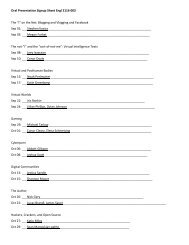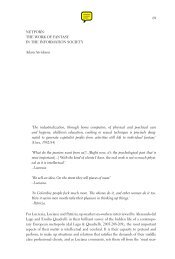Nakamura, Digitizing Race, Introduction, chapter 5, Epilogue
Nakamura, Digitizing Race, Introduction, chapter 5, Epilogue
Nakamura, Digitizing Race, Introduction, chapter 5, Epilogue
You also want an ePaper? Increase the reach of your titles
YUMPU automatically turns print PDFs into web optimized ePapers that Google loves.
78 Alllooksame?<br />
on the impact and meaning of television adoption in preliterate societies,<br />
there has been relatively little on Internet adoption, though the popularity<br />
and spread of cybercafés and gaming parlors on the global scene certainly<br />
signal the massification of the medium among wider numbers of users. New<br />
media collectives such as Sarai in New Delhi work to facilitate the adoption<br />
and deployment of digital media among some of India’s poorest users, many<br />
of whom are preliterate. This exploitation of the Internet’s increasingly<br />
visual and graphical nature works to empower users of color in a way that is<br />
useful to oppose the reification of race through visual means online. In this<br />
<strong>chapter</strong> I begin by analyzing the Web site alllooksame.com to parse the<br />
ways that race is ultimately deconstructed as a visually meaningful term. My<br />
position is that rather than resulting in successful racial profiling, the site<br />
provides more occasions for racial misrecognitions, thus exposing the active<br />
process of the reification of race. I end the <strong>chapter</strong> with an assessment of<br />
postcolonial theoretical stances regarding Internet adoption across ethnic<br />
and national borders. Clearly there is much at stake in this debate: the<br />
Internet is feared by many postcolonial media and technology critics partly<br />
because they see it as an obstacle to the preservation of rare or endangered<br />
languages. 13 The dominance of majority languages like English and Japanese<br />
could potentially contribute to the eradication of rarer languages like Navajo,<br />
languages with possible use value beyond their use as codes during a war.<br />
Web sites such as Dyske Suematsu’s alllooksame.com effectively employ<br />
interactivity and the spectacle of race online in ways that offer distinctive<br />
forms of resistance to racial and visual categories. Alllooksame.com critiques<br />
vision itself as a way of understanding race, culture, and the body both online<br />
and off. There is a tendency in new media criticism to valorize ethnic identity<br />
Web sites that have an overtly progressive political stance as being more<br />
culturally “authentic” (and thus less corrupted by the West) than others. 14 I<br />
chose to examine alllooksame.com because it is a space produced by an<br />
Asian designer for an Asian and Asian American audience that debates national<br />
and ethnic identities rather than simply affirming them. In addition,<br />
alllooksame.com is a comedic site and thus part of a dramatically underexamined<br />
genre that gets little critical attention even from Net critics. 15<br />
Alllooksame.com is a weird, weird site. Interacting with it produces a mixture<br />
of guilt and fascination and a lingering feeling of discomfort. In short, it is<br />
uncanny. The initial screen features the familiar iconography of a Scantron<br />
exam form with its ranks of numbered oval blanks, along with a “welcome”<br />
narrative that reads:





